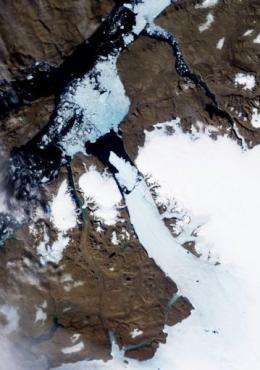A satellite image of the Petermann Glacier taken by the Moderate Resolution Imaging Spectroradiometer (MODIS) on August 5. The largest ice island in almost 50 years poses no immediate threat as it will take up to two years to drift through the Arctic Ocean, the Canadian who discovered it told AFP on Wednesday.
The largest ice island in almost 50 years poses no immediate threat as it will take up to two years to drift through the Arctic Ocean, the Canadian who discovered it told AFP.
Trudy Wohlleben, a forecaster from the Canadian Ice Service, spotted the massive slab of ice that broke off a glacier in Greenland last week as she analyzed raw data from a NASA satellite.
At about 30 kilometers (18.6 miles) long and 10 kilometers wide, the ice island is about four times the size of Manhattan and experts say the last time the Arctic lost such a large chunk was in 1962.
Wohlleben played down fears the giant iceberg would pose an immediate threat to oil platforms or shipping lanes, saying it would first have to navigate a series of small islands in the Nares Strait.
It is likely to get broken down into smaller chunks before it reaches the shipping lanes off the Labrador Coast in Newfoundland, she said, and could even become lodged in a channel or stuck to land.
"In the next one to two years it could reach the east coast of Canada," she told AFP, explaining that unlike in the days when the Titanic sank in 1912, ships now have the latest satellite data to warn them of dangerous icebergs.
Satellite images of the area show that the Petermann glacier lost about one-quarter of floating ice-shelf. The phenomenon is known as "ice calving."
"On August 3, it was not there. Then the clouds prevented pictures from being taken, and on Thursday August 5 I saw it in the morning," Wohlleben recounted.
The Petermann glacier is one of Greenland's two largest that end in floating shelves and connects the Danish territory's ice sheet directly with the ocean.
Scientists have said that while global warming probably contributed to the break, ocean currents and Arctic winds could also be responsible.
Wohlleben refused to be drawn on the climate debate.
"It is hard to say," she told AFP. "There are just so many factors that could play a role."
Paal Prestrud, the head of the climate research group Cicero, said warmer waters likely caused the block of ice to break away, but added: "It's difficult to say for sure it's due to global warming.
"But you see the same things happening all around Greenland, ice shelves breaking up, the outletting glaciers are increasing their speed and retreating faster and faster, and the total mass of ice is decreasing."
(c) 2010 AFP






















